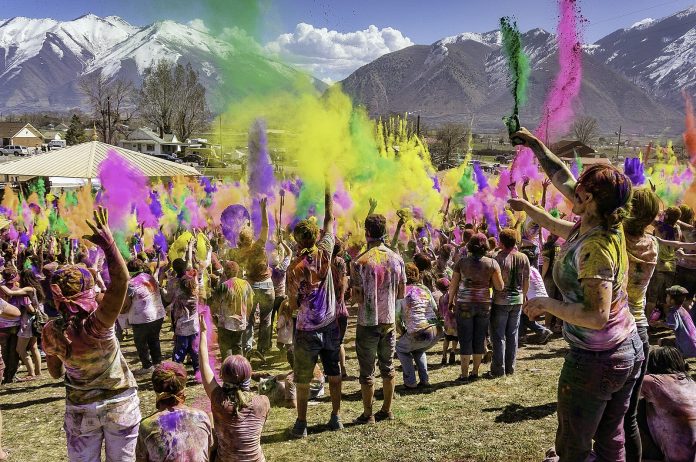by Aneela Mirchandani
Wherever the Indian diaspora goes, they bring the color with them.
This is particularly true around spring when Indians worldwide celebrate Holi, the festival of colors.
From Seattle’s third annual Color Festival to a rooftop celebration on Fifth Avenue in New York City where DJs spun Bhangra beats, to a beach Holi party in Redondo Beach where Bollywood celebrities are expected to appear, there has been no shortage of Holi events across the US.
The festival officially fell on March 14 this year, but communities across the country held Holi events on the following weekend—with more celebrations continuing into April and May.
“In America, we seem to have a Holi season,” said Suhag Shukla, executive director at Hindu American Foundation (HAF). Last week, HAF hosted their own festivities jointly with Bay Area Jewish groups, in a combined Holi-Purim festival—since both Holi and Purim celebrate spring.
Communities gather to dance, to eat, and most importantly, to spray vibrantly-colored water and bright powders upon each other with abandon. White clothing is the norm so the vibrant colors can truly stand out. By the end of the day, the exhausted revelers show off their multicolored faces and clothes.
While color play is the most iconic ritual, Holi has a deeper meaning as well, said HAF’s managing director Samir Kalra.
“Holi represents harmony and new beginnings, and encourages people to renew our efforts at becoming better human beings,” Kalra said in an email.
It also brings communities together.
“Holi symbolizes unity, and the breaking down of social barriers,” said Bhushan Mocherla, a philanthropist who is building a monastery as a “center of excellence” in Georgia. “Barriers between genders, between people of different classes and backgrounds. In America, Holi breaks downs the barriers between Indians and Americans.”
Last week, Texas, the land of the all-American cowboy, became the third US state to recognize Holi as a cultural celebration. Texas’s resolution was widely seen as a milestone in the coming of age of the Indian diaspora.
Most festivals are about spending time with family, said Pushpita Prasad, chief of communications at the Coalition of Hindus of North America (CoHNA), but Holi is unique—it is centered on community, on people of the village or the neighborhood, people one may not know very well.
“After a well-played Holi you won’t even recognize each other anyway,” Prasad joked.
At the same time, said Prasad, the roots of Holi go deep into antiquity, with references to Holi found in ancient Indian scriptures from over 2000 years ago. In the old days, the colors were made from natural materials.
“Ancients used turmeric mixed with lime which made a red dye,” said Prasad, “and they also used beetroot, saffron, etc.”
Holi gains its significance from Hinduism, one of the world’s oldest religions. While each region of India and Nepal might ascribe its own meanings to the rituals of Holi, each in their own ways symbolizes renewal and celebration.
The color play, said Shukla, commonly symbolizes the playful enjoyment of the Hindu deity Lord Krishna and his consort Radha.
Some celebrations in the United States maintain their connection to these very ancient roots. One such will be held in May at the Braj temple of Holbrook, Massachusetts, whose founder, Keshav Kishor Sharan, was raised in Lord Krishna’s hometown of Vrindavan in north India, and has since spread a message of environmentalism and inclusivity.
The meaning of Holi, said Sewak Sharan, a priest at the temple, is “a celebration of color, where everyone is one family, and everyone is welcome with no restrictions. With lots of music, lots of food, lots of dancing.”
While Holi is often denoted as a “spring” festival, it does not fall precisely on the advent of the spring season. Instead, it follows the lunar calendar ascribed by the ancients of India.
“Holi falls on the purnima (full-moon) of Phalguna, the last month of the Hindu lunar calendar that occurs between February and March,” said Kalra.
By now many in North America have become acquainted with the exuberance of Holi’s color play. But few know about the ritual bonfires that light up all over India on Holi’s eve, symbolizing the victory of good over evil. In the bonfires, the effigy of a demoness known as Holika, the sister of a mythological king who set himself above God, is ritually set alight.
While Prasad said she was delighted the Indian diaspora had managed to recreate the joy and community of Holi so far from India’s shores, she warned against the cultural appropriation of the festival.
“Some celebrate Holi without acknowledging its deep roots,” Prasad said. She gave the example of Color Run, a non-denominational charity run that is held in multiple countries around the time of Holi without acknowledging where the tradition comes from.
She also objected to what she called the “South Asiafication” of the festival—denoting it as a ritual observed all over South Asia. “The reality is, celebrating Holi in Afghanistan, Pakistan, or Bangladesh can get you into serious trouble,” she said. “All are welcome to celebrate Holi, just as we celebrate Christmas. But we have to acknowledge that Holi is a festival firmly rooted in the Hindu tradition.”
AsAmNews is published by the non-profit, Asian American Media Inc.
We’re now on BlueSky. You can now keep up with the latest AAPI news there and on Instagram, TikTok, Facebook, YouTube and X.
We are supported by generous donations from our readers and by such charitable foundations as the Robert Wood Johnson Foundation.
You can make your tax-deductible donations here via credit card, debit card, Apple Pay, Google Pay, PayPal and Venmo. Stock donations and donations via DAFs are also welcomed.


